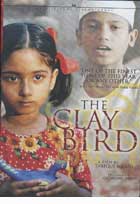
The Clay Bird (Matir Moina) 2002
Distributed by Milestone Films & Video, PO Box 128, Harrington Park, NJ 07640-0128; 800-603-1104
Produced by Catherine Masud
Directed by Tareque Masud
DVD, color, 89 min.
College - Adult
Multicultural Studies, Asian Studies, Religious Studies, History, Film Studies
Date Entered: 12/12/2006
Reviewed by Charles Burkart, Media Bibliographer, West Virginia University, Morgantown, WVThis is my first opportunity to write a review of a feature film for Educational Media Reviews Online. The Clay Bird is a personal, semi-autobiographical portrait of Bangladesh on the eve of its separation from Pakistan. The film’s main protagonist Anu (Anwar), a young country boy, is sent to a Madrasah (Islamic religious boarding school) by his overly devout Muslim father, Kazi, to escape all that “Hindu rubbish.” Kazi is a closed-minded, homeopathic pharmacist, who has a falling out with his secular Marxist brother and his more practical, easygoing wife, who disagrees with his childrearing practices.
At the Madrasah Anu is befriended by Rokon (a gentle outcast) and Ibrahim a thoughtful and kindhearted, Islamic teacher. Unfortunately, tragedy strikes his family with the unnecessary death of his sister, Asma, due to his father’s stubborn refusal to use Western antibiotics, and a devastating attack by Pakistani troops on their village to prevent Bangladeshi independence. Meanwhile at the Madrasah, troubled Rokon is forced to undergo a life-threatening exorcism by his intimidating Muslim headmaster.
The Clay Bird calls to mind Satyajit Ray’s deeply moving childhood epic of rural India, Pather Panchali, and Victor Erice’s delightful childhood fantasy El Espiritu de la Colmena (Spirit of the Beehive). Certainly, the scene where Rokon leads Anu into his enchanted garden made up of unwanted, castoff junk directly behind the Madrasah is one of those ravishingly beautiful moments that can make cinema a high art form.
The vivid characters in The Clay Bird are well developed and grow with their experiences. For instance, Kazi, after the death of his daughter, begins to have doubts about the infallibility of homeopathic medicine. Moreover, the brutal behavior of his Islamic brothers from Pakistan causes Kazi to question his extreme religious views.
The Clay Bird is beautifully photographed with breathtaking cinematography and color. The film’s editing is uniformly good and fast paced. Camera shots are framed with an artist’s eye to maximum aesthetic affect. The actors are all non professional amateurs, but they give memorable performances just the same. The music is authentic devotional folk music, which comes from a great South Asian tradition. In addition, the musical interludes are filmed in actual town squares and around village campfires.
The Clay Bird is one of the first Bangladeshi movies to receive international acclaim. The film was the winner of the International Critics Prize at Cannes in 2002. “True religion opens people’s eyes,” says the philosophical Muslim ferryman Karim in the The Clay Bird. This amazing film will open your eyes to a universe of wonder. Unlike the clay bird of the film’s title trapped in earthly materialism, this film soars like a graceful eagle on a summer breeze. I highly recommend The Clay Bird for film studies classes, Asian studies, religious studies and general enrichment at the college and university level. It is a minor masterpiece.